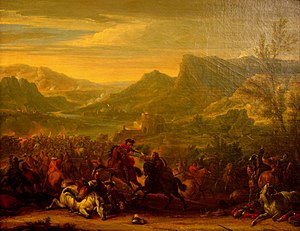Battle of Calcinato
| date | April 19, 1706 |
|---|---|
| place | Calcinato ( Lombardy ) |
| output | Franco-Spanish victory |
| Parties to the conflict | |
|---|---|
| Commander | |
| Troop strength | |
| 58 battalions of infantry, 65 squadrons of cavalry, 44 artillery pieces together around 41,000 men | 37 battalions of infantry, 15 squadrons of cavalry, 16 guns, a total of 19,000 men |
| losses | |
|
500 men |
between 3000-7000 men |
Carpi - Chiari - Cremona - Kaiserswerth - Luzzara - Cádiz - Friedlingen - Vigo - Schmidmühlen - Ekeren - Höchstädt (1703) - Gibraltar - Speyerbach - Schellenberg - Bonn - Höchstädt (1704) - Vélez-Málaga - Cassano - Barcelona (1705) - Sendlinger Murder Christmas - Calcinato - Ramillies - Turin - Castiglione - Almansa - Toulon - Lille - Oudenaarde - Malplaquet - Almenara - Saragossa - Brihuega - Villaviciosa - Denain - Rio de Janeiro - Barcelona
The Battle of Calcinato (often also called Meeting at Calcinato ) on April 19, 1706 took place during the War of the Spanish Succession between Imperial troops and the allied French and Spanish. The encounter ended with a clear defeat for the imperial family.
prehistory
Eugene of Savoy had previously left the theater of war and traveled to Vienna . On the French side, Louis II Joseph de Bourbon, duc de Vendôme had received considerable reinforcements. He commanded about 41,000 men. Vendôme intended to use Eugene of Savoy's absence for offensive actions.
The imperial army stood at Montichiari and Calcinato about 18 kilometers southeast of Brescia . The camps were fortified. The Imperialists were under the command of Christian Detlev von Reventlow and were about 19,000 strong. Among them was a Prussian contingent. Reventlow had waited in vain for reinforcements. The imperial commander suspected that a French attack was imminent, but was surprised.
Course and consequences
The Imperialists were surprised by the French army and attacked from two sides. As a result of the surprise effect, the allied army suffered a heavy defeat in the following battle.
The information on losses varies. The French side spoke of 7,000, the Austrian side of 3,000 men. The Prussian contingent alone lost 2,000 men. On the French side there were 500 dead and wounded.
The imperial ones withdrew in an orderly manner at the beginning, but soon the order subsided. On the evening of the battle, Eugene of Savoy rejoined the army. He gathered the troops and led them towards Trento . Eugene of Savoy took the opportunity to remind the emperor of the need for reinforcements and supplies in good time.
Individual evidence
- ↑ here was used: Gaston Bodart: Militär-Historisches Kriegs-Lexikon, (1618–1905). Vienna, 1908 p. 146
literature
- Von Alten: Handbook for Army and Navy. Vol. 2 Berlin, 1910 pp. 659f
